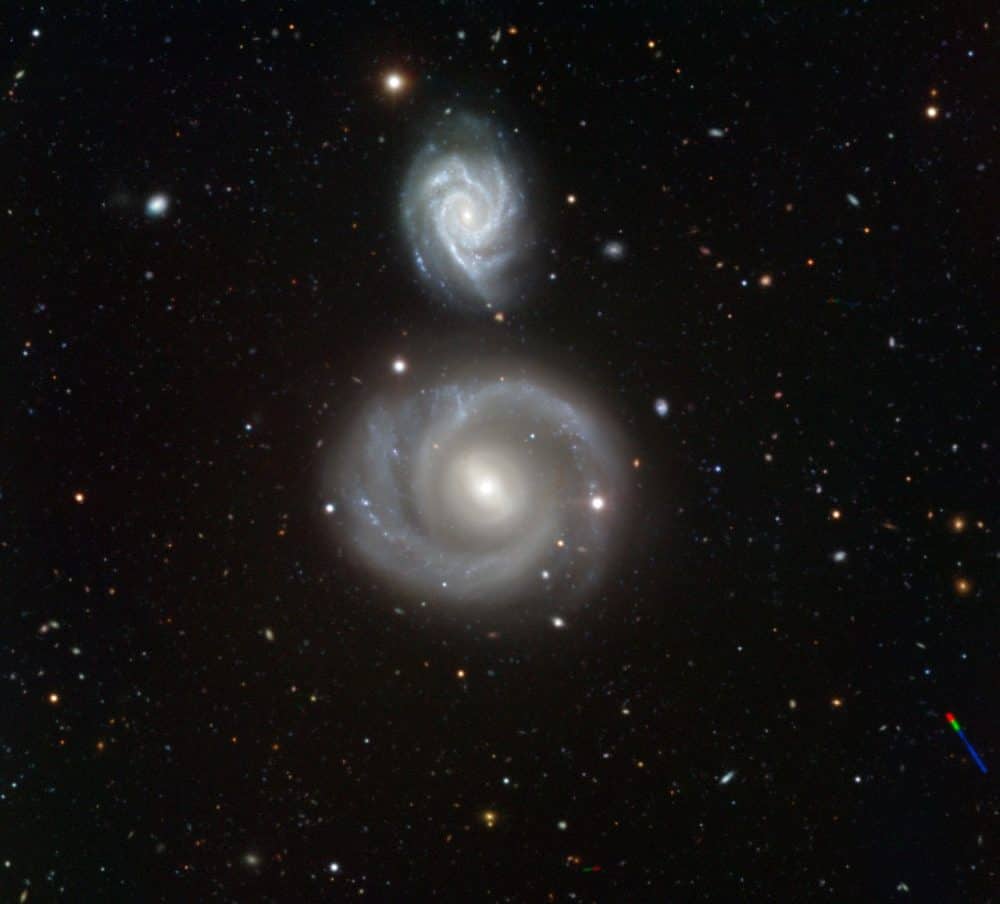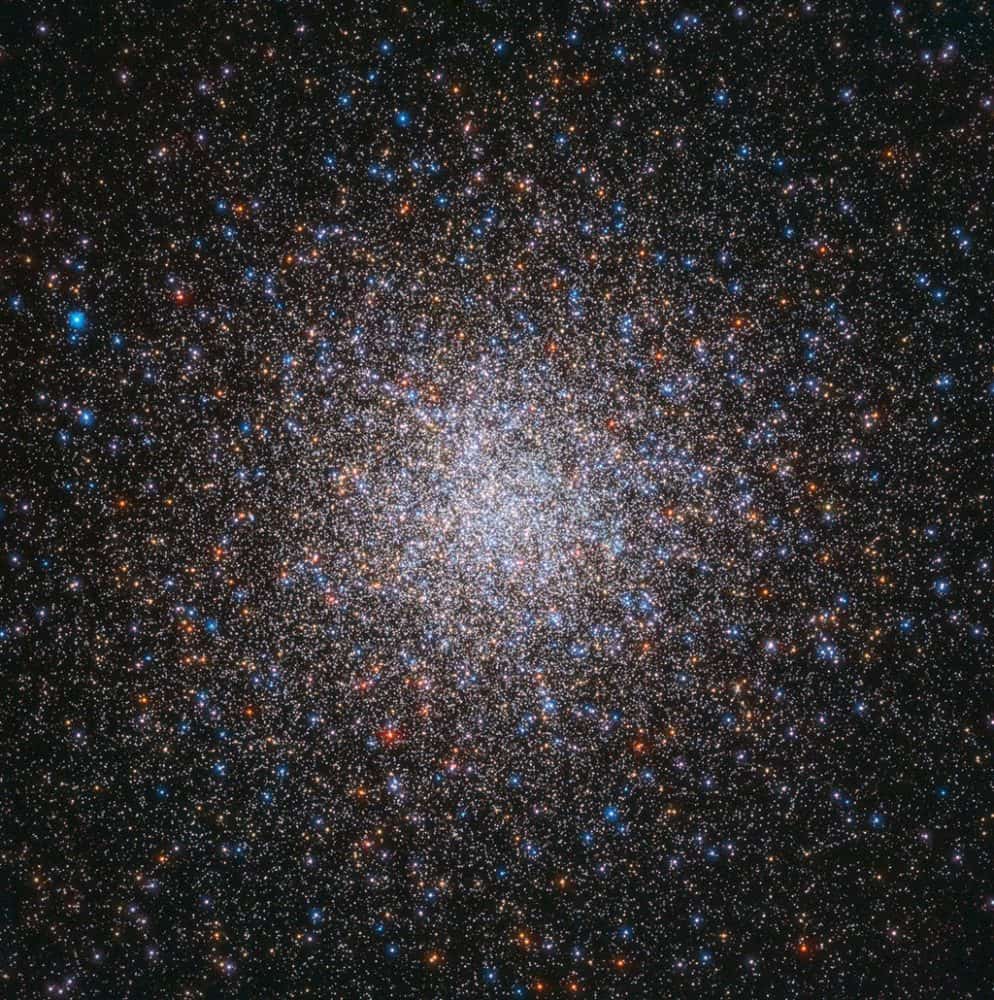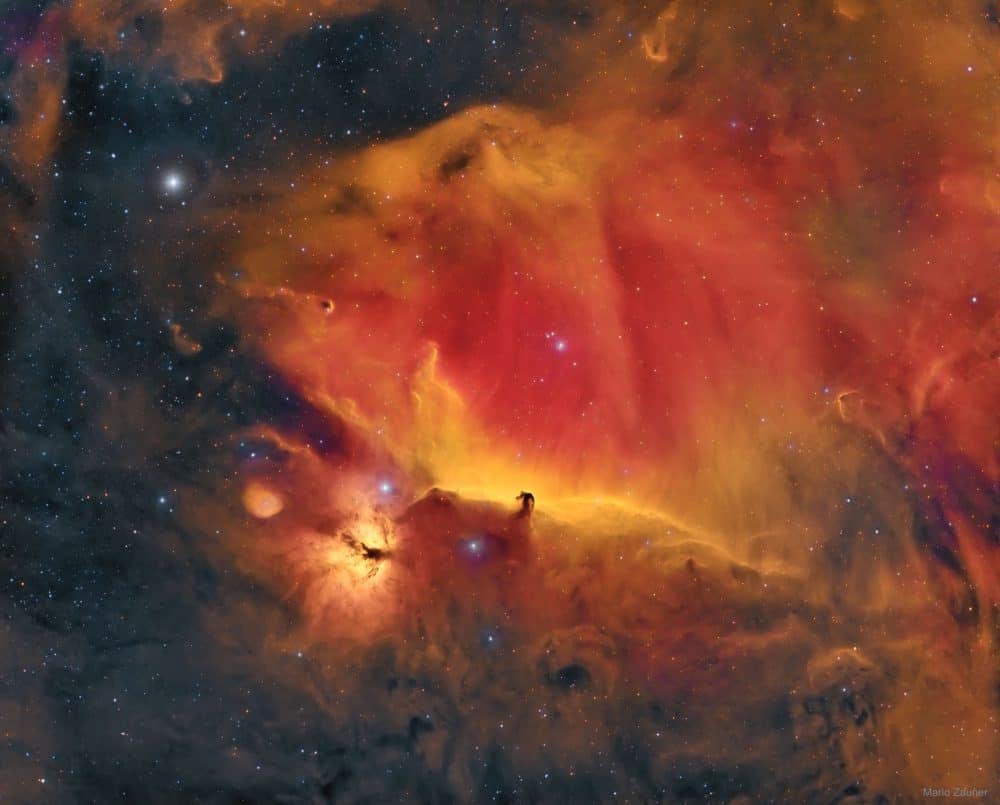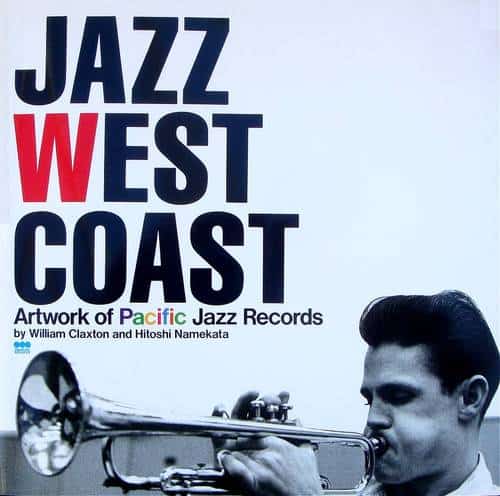Blog
This beautiful image portrays the galaxies NGC 799 (below) and NGC 800 (above) located in the constellation of Cetus (The Whale). This pair of galaxies was first observed by the American astronomer Lewis Swift back in 1885.
Located at a distance of about 300 million light-years, our face-on view allows us to clearly appreciate their shapes. Like the Milky Way — our galaxy — these objects are both spiral galaxies, with characteristic long arms winding towards a bright bulge at the centre. In the prominent spiral arms, a large number of hot, young, blue stars are forming in clusters (tiny blue dots seen in the image) whereas in the central bulge a large group of cooler, redder, old stars are packed into a compact, almost spherical region.
At first glance, these galaxies look rather similar, but the devil is in the detail. Apart from the obvious difference in size, only NGC 799 has a bar structure, extending from its central bulge, and the spiral arms wind out from the ends of the bar. Galactic bars are thought to act as a mechanism that channels gas from the spiral arms to the centre, intensifying star formation. A supernova was also observed in NGC 799 in 2004, and was given the name SN2004dt.
Another interesting differentiating feature is the number of spiral arms. The small NGC 800 has three bright, knotty spiral arms, whilst NGC 799 only has two relatively dim, but broad spiral arms. These start at the end of the bar and wrap nearly completely around the galaxy forming a structure that looks almost like a ring.
While it might seem that this image depicts two impressive close spiral galaxies coexisting in an everlasting peace, nothing can be further than the truth. We could be just witnessing the calm before the storm. We don’t know exactly what the future will bring, but typically, when two galaxies are close enough, they interact over hundreds of millions of years by means of gravitational disturbances. In some cases, only minor interactions occur, causing shape distortions, but sometimes galaxies collide, merging to form a single, new and larger galaxy.
more...Paul Oscher (born April 5, 1950) is an American blues singer, songwriter, and instrumentalist.
He first began playing harmonica at the age of 12. His career as a musician began at the age of 15 when he played for the musician Little Jimmy Mae.
Oscher played harmonica as a member of the Muddy Waters Blues Band from 1967 until 1972. He was the first Caucasian musician in Muddy’s band and lived in Muddy’s house on Chicago’s South Side and shared the basement with the blues pianist Otis Spann. Oscher recorded with Muddy for Chess Records, and in 1976 he toured Europe with Louisiana Red. They both appeared at the WDR-TV music show Rockpalast. In 1999, he played with Big Bill Morganfield on his debut album, Rising Son. In 2003 Oscher was featured on harmonica, guitar and vocals on Hubert Sumlin‘s album About Them Shoes, along with Keith Richards, Eric Clapton and Levon Helm. In 2006, Oscher collaborated with Mos Def and recorded the song “Bed Stuy Parade and Funeral March” on Mos Def’s album The New Danger. In 2008 he recorded with Keb’ Mo’ on the soundtrack of a film about the blues, Who Do You Love?.
more...Stanley William Turrentine (April 5, 1934 – September 12, 2000) was an American jazz tenor saxophonist. He began his career playing R&B for Earl Bostic and later soul jazz recording for the Blue Note label from 1960, touched on jazz fusion during a stint on CTI in the 1970s. He was described by critic Steve Huey as “renowned for his distinctively thick, rippling tone [and] earthy grounding in the blues.” Turrentine was married to organist Shirley Scott in the 1960s, with whom he frequently recorded, and was the younger brother of trumpeter Tommy Turrentine.
Turrentine was born in Pittsburgh‘s Hill District into a musical family. His father, Thomas Turrentine, Sr., was a saxophonist with Al Cooper’s Savoy Sultans, his mother played stride piano, and his older brother Tommy Turrentine became a professional trumpet player.
He began his prolific career with blues and rhythm and blues bands, and was at first greatly influenced by Illinois Jacquet. In the 1950s, he went on to play with the groups of Lowell Fulsonand Earl Bostic. In Bostic’s group, he replaced John Coltrane in 1953 and also played in groups led by the pianist and composer Tadd Dameron.
Turrentine received his only formal musical training during his military stint in the mid-’50s. In 1959, he left the military and went straight into the band of the drummer Max Roach.
He married the organist Shirley Scott in 1960 and the two frequently played and recorded together. In the 1960s, he started working with organist Jimmy Smith, and made many soul jazzrecordings both with Smith and as a leader.
https://www.youtube.com/watch?v=YTQbhLnrqFo
more...Billy Bland (April 5, 1932, Wilmington, North Carolina – March 22, 2017, New York City) was an American R&B singer and songwriter.
Bland, the youngest of 19 children, first sang professionally in 1947 in New York, and sang with a group called The Bees in the 1950s on New Orleans‘s Imperial Records. In 1954, “Toy Bell” by the group caused some unrest by veering into the dirty blues genre. Dave Bartholomew brought them to New Orleans, where they recorded a song he had written and recorded twice before: firstly in 1952 for King Records as “My Ding-a-Ling,” and later that year for Imperial as “Little Girl Sing Ting-A-Ling.” Bland later pursued a solo career.
In 1960, Bland heard Titus Turner recording the song “Let the Little Girl Dance” in the studio, and demonstrated for Turner how to sing it (along with guitarist Mickey Baker and other session musicians). The event was recorded by record producer Henry Glover, and was eventually released as a single. The tune was a hit in the U.S., peaking at number 11 on the US BillboardR&B chart. and number 7 on the Billboard Hot 100. Bland had two other minor hits that year, “Harmony” (U.S. Hot 100 number 91) and “You Were Born to Be Loved” (U.S. Hot 100 number 94). He recorded until 1963 for Old Town, and then quit the music industry.
In the 1980s, he ran a soul food restaurant in Harlem.
more...Flamenco Fridays with Alegrias.
Alegrías (Spanish pronunciation: [aleˈɣɾi.as]) is a flamenco palo or musical form, which has a rhythm consisting of 12 beats. It is similar to Soleares. Its beat emphasis is as follows: 1 2 [3] 4 5 [6] 7 [8] 9 [10] 11 [12]. Alegrías originated in Cádiz. Alegrías belongs to the group of palos called Cantiñas and it is usually played in a lively rhythm (120-170 beats per minute). The livelier speeds are chosen for dancing, while quieter rhythms are preferred for the song alone.
One of the structurally strictest forms of flamenco, a traditional dance in alegrías must contain each of the following sections: a salida (entrance), paseo (walkaround), silencio (similar to an adagio in ballet), castellana (upbeat section) zapateado (Literally “a tap of the foot”) and bulerías. This structure though, is not followed when alegrías are sung as a standalone song (with no dancing). In that case, the stanzas are combined freely, sometimes together with other types of cantiñas.
more...
After the Crab Nebula, M1, this giant star cluster is the second entry in 18th century astronomer Charles Messier’s famous list of things with are not comets. M2 is one of the largest globular star clusters now known to roam the halo of our Milky Way galaxy. Though Messier originally described it a nebula without stars, this stunning Hubble image resolves stars across the central 40 light-years of M2. Its population of stars numbers close to 150,000, concentrated within a total diameter of around 175 light-years. About 55,000 light-years distant toward the constellation Aquarius, this ancient denizen of the Milky Way, also known as NGC 7089, is 13 billion years old.
more...Hugh Ramapolo Masekela (4 April 1939 – 23 January 2018) was a South African trumpeter, flugelhornist, cornetist, composer and singer. He has been described as “the father of South African jazz.” Masekela was known for his jazz compositions and for writing well-known anti-apartheid songs such as “Soweto Blues” and “Bring Him Back Home“. He also had a number-one US pop hit in 1968 with his version of “Grazing in the Grass“.
A renewed interest in his African roots led Masekela to collaborate with West and Central African musicians, and finally to reconnect with Southern African players when he set up with the help of Jive Records a mobile studio in Botswana, just over the South African border, from 1980 to 1984. Here he re-absorbed and re-used mbaqanga strains, a style he continued to use following his return to South Africa in the early 1990s.
In 1985 Masekela founded the Botswana International School of Music (BISM), which held its first workshop in Gaborone in that year. The event, still in existence, continues as the annual Botswana Music Camp, giving local musicians of all ages and from all backgrounds the opportunity to play and perform together. Masekela taught the jazz course at the first workshop, and performed at the final concert.
Also in the 1980s, Masekela toured with Paul Simon in support of Simon’s album Graceland, which featured other South African artists such as Ladysmith Black Mambazo, Miriam Makeba, Ray Phiri, and other elements of the band Kalahari, with which Masekela recorded in the 1980s. He also collaborated in the musical development for the Broadway play, Sarafina! and recorded with the band Kalahari.
Masekela in Cambridge, Massachusetts, June 2013
In 2003, he was featured in the documentary film Amandla!: A Revolution in Four-Part Harmony. In 2004, he released his autobiography, Still Grazing: The Musical Journey of Hugh Masekela, co-authored with journalist D. Michael Cheers,[31] which detailed Masekela’s struggles against apartheid in his homeland, as well as his personal struggles with alcoholism from the late 1970s through to the 1990s. In this period, he migrated, in his personal recording career, to mbaqanga, jazz/funk, and the blending of South African sounds, through two albums he recorded with Herb Alpert, and solo recordings, Techno-Bush (recorded in his studio in Botswana), Tomorrow (featuring the anthem “Bring Him Back Home”), Uptownship (a lush-sounding ode to American R&B), Beatin’ Aroun de Bush, Sixty, Time, and Revival. His song “Soweto Blues“, sung by his former wife, Miriam Makeba, is a blues/jazz piece that mourns the carnage of the Soweto riots in 1976.[32] He also provided interpretations of songs composed by Jorge Ben, Antônio Carlos Jobim, Caiphus Semenya, Jonas Gwangwa, Dorothy Masuka and Fela Kuti.
more...Jake Hanna (April 4, 1931 – February 12, 2010) was an American jazz drummer.
Hanna first performed in his home town of Boston. He was the house drummer at Storyville for a number of years in the 1950s and 1960s. He played with Toshiko Akiyoshi (1957), Maynard Ferguson (1958), Marian McPartland (1959–61), and Woody Herman‘s Orchestra (1962–64). He appears with the Mort Lindsey Orchestra on Judy Garland‘s multi Grammy award-winning live album, Judy at Carnegie Hall (1961). He did extensive work as a studio musician both in and out of jazz, including a period as the drummer for the big band of the Merv Griffin Show(1964–75). He recorded several albums with Carl Fontana for Concord Jazz in the mid-1970s and also played in Supersax. Later in his career he did much work as a sideman for Concord.[1]Hanna died on February 12, 2010 in Los Angeles, California of complications from blood disease.
more...McKinley Morganfield (April 4, 1913 – April 30, 1983), known professionally as Muddy Waters, was an American blues singer-songwriter and musician who is often cited as the “father of modern Chicago blues“, and an important figure on the post-war blues scene.
Muddy Waters grew up on Stovall Plantation near Clarksdale, Mississippi, and by age 17 was playing the guitar and the harmonica, emulating the local blues artists Son House and Robert Johnson. He was recorded in Mississippi by Alan Lomax for the Library of Congress in 1941. In 1943, he moved to Chicago to become a full-time professional musician. In 1946, he recorded his first records for Columbia Records and then for Aristocrat Records, a newly formed label run by the brothers Leonard and Phil Chess.
In the early 1950s, Muddy Waters and his band—Little Walter Jacobs on harmonica, Jimmy Rogers on guitar, Elga Edmonds (also known as Elgin Evans) on drums and Otis Spann on piano—recorded several blues classics, some with the bassist and songwriter Willie Dixon. These songs included “Hoochie Coochie Man“, “I Just Want to Make Love to You” and “I’m Ready“. In 1958, he traveled to England, laying the foundations of the resurgence of interest in the blues there. His performance at the Newport Jazz Festival in 1960 was recorded and released as his first live album, At Newport 1960.
Muddy Waters’ influence is incalculable, on blues as well as other American idioms—such as Rock and roll and Rock music.
Muddy Waters’ birthplace and date are not conclusively known. He stated that he was born in Rolling Fork, Mississippi, in 1915, but other evidence suggests that he was born in Jug’s Corner, in neighboring Issaquena County, in 1913.In the 1930s and 1940s, before his rise to fame, the year of his birth was reported as 1913 on his marriage license, recording notes, and musicians’ union card. A 1955 interview in the Chicago Defender is the earliest in which he stated 1915 as the year of his birth, and he continued to say this in interviews from that point onward. The 1920 census lists him as five years old as of March 6, 1920, suggesting that his birth year may have been 1914. The Social Security Death Index, relying on the Social Security card application submitted after his move to Chicago in the mid-1940s, lists him as being born April 4, 1913. His gravestone gives his birth year as 1915.
more...The famous Horsehead Nebula in Orion is not alone. A deep exposure shows that the dark familiar shaped indentation, visible just below center, is part of a vast complex of absorbing dust and glowing gas. To bring out details of the Horsehead’s pasture, an amateur astronomer used a backyard telescope in Austria to accumulate and artistically combine 7.5 hours of images in the light of Hydrogen (red), Oxygen (green), and Sulfur (blue). The resulting spectacular picture details an intricate tapestry of gaseous wisps and dust-laden filaments that were created and sculpted over eons by stellar winds and ancient supernovas. The Flame Nebula is visible just to the left of the Horsehead, while the bright star on the upper left is Alnilam, the central star in Orion’s Belt. The Horsehead Nebula lies 1,500 light years distant towards the constellation of Orion.
more...Harold Vick (April 3, 1936 – November 13, 1987) was an American hard bop and soul jazz saxophonist and flautist.
Harold Vick was born on April 3, 1936 in Rocky Mount, North Carolina. At the age of 13 he was given a clarinet by his uncle, Prince Robinson,[1] a clarinet and tenor saxophone player who had been a member of McKinney’s Cotton Pickers. Three years later he took up the tenor saxophone, and soon began playing in R&B bands. He continued to perform, still largely with R&B bands, while studying psychology at Howard University.
Steppin’ Out!, Vick’s first album as leader, was recorded for Blue Note in 1963. After a 1965 performance at Carnegie Hall with Donald Byrd, Vick secured a contract for further albums as leader, and from 1966 to 1974 he had further recording sessions for the RCA, Muse, and Strata-East labels.
https://www.youtube.com/watch?v=_JQlKNwqJJA
more...Rocco Scott LaFaro (April 3, 1936 – July 6, 1961) was an American jazz double bassist known for his work with the Bill Evans Trio.
Beginning in 1955, he was a member of the Buddy Morrow big band. He left that organization to work in Los Angeles. LaFaro spent most of his days practicing his instrument. He practiced with a clarinet book to improve his facility. Bassist Red Mitchell taught him how to pluck strings with both the index and middle fingers independently. For much of 1958 he was with Victor Feldman‘s band.
In 1959, after working with Chet Baker, Stan Kenton, Cal Tjader, and Benny Goodman, LaFaro returned to the east and joined Bill Evans, who had recently left the Miles Davis Sextet. With Evans and drummer Paul Motian he developed the counter-melodic style that would come to characterize his playing. Evans, LaFaro, and Motian were committed to the idea of three equal voices in the trio, working together for a singular musical idea often without the time stated.
By late 1960, LaFaro was in demand as a bassist. He replaced Charlie Haden as Ornette Coleman‘s bassist in January 1961. For a time, Haden and LaFaro shared an apartment. He also played in Stan Getz’s band between jobs with the Bill Evans trio. Around this time he received a greeting card from Miles Davis suggesting that Davis wanted to hire him.
In June 1961, the Bill Evans trio began two weeks of performances at the Village Vanguard in New York City. The trio attracted attention for its style. The last day was recorded for two albums, Sunday at the Village Vanguard and Waltz for Debby.
more...James Harrell McGriff (April 3, 1936 – May 24, 2008) was an American hard bop and soul-jazz organist and organ trio bandleader.
Born in Germantown, Pennsylvania, McGriff started playing piano at the age of five and by his teens had also learned to play vibes, alto sax, drums and upright bass. His first group was as bassist in a piano trio. When he joined the United States Army, McGriff served as a military policeman during the Korean War. He later became a police officer in Philadelphia for two years.
Music kept drawing McGriff’s attention away from the police force. His childhood friend, organist Jimmy Smith, had begun earning a substantial reputation in jazz for his Blue Note albums (the two played together once in 1967) and McGriff became entranced by the organ sound while Richard “Groove” Holmes played at his sister’s wedding. Holmes went on to become McGriff’s teacher and friend and they recorded together on two occasions in 1973 for two Groove Merchant records.
McGriff bought his first Hammond B-3 organ in 1956, spent six months learning the instrument, then studied at New York’s Juilliard School. He also studied privately with Milt Buckner, Jimmy Smith, and Sonny Gatewood. He was influenced by the energy and dynamics of organist Buckner and the diplomatic aplomb of Count Basie, and by local organists such as Howard “The Demon” Whaley and Austin Mitchell.
more...I forgot how important Jazz is on the West Coast; an institution!
https://kkjz.org/programming/listen/stream/
Finally made it to Point Dume State Beach west of Malibu, funky & laid back; had to traffic through 101 N & down beautiful Topanga Canyon from Universal City whewwwww
more...More Posts
- Ray Mantilla Day
- Cal Green Day
- World Music with ESTRELLA MORENTE
- Daily Roots with Sizzla
- The Cosmos with NGC 5426/27
- Eric Reed Day
- Lalo Schifrin
- Skip James Day
- World Music with Alekos K. Vretos
- Daily Roots with Ijahman Levy
- The Cosmos with M16
- Eric Dolphy Day
- Lazy Lester Day
- World Music with Obo Addy
- Daily Roots with Bob Marley
- The Cosmos with Fleming 1
- Ernest Ranglin Day
- Billy Drummond Day
- World Music with Lela Tataraidze
- Daily Roots with the Skatalites





